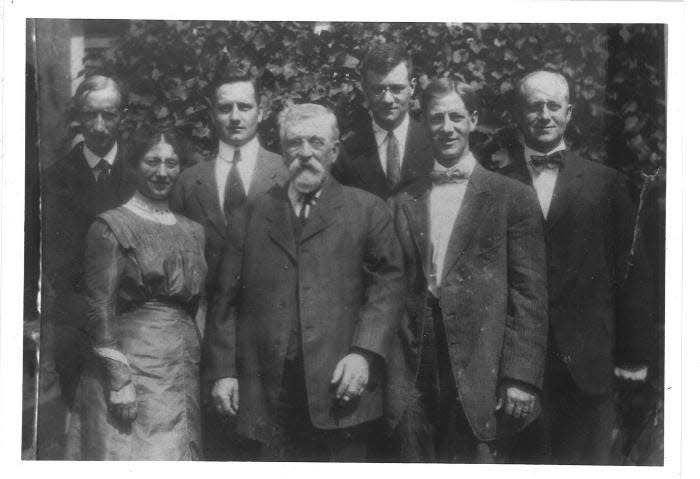Steve VanderVeen: The family who owned Nies Hill

Many locals remember Nies Hill. Here is the first part of the story about the family who owned it.
Jan Derk Nies was born in the city of Groningen, Netherlands. He emigrated to America in 1852 with his parents, Derk Jans and Ikien Niewenhuis Nies. The Nies family settled in Fillmore Township. Unfortunately, Derk Jans died soon after their arrival, leaving Jans Derk, then 24, the oldest male in the family.
In 1862, encouraged by Albertus Van Raalte, Jan volunteered to fight in the Civil War, not a universal sentiment. After returning in 1865, Jan married Johanna Kruisinga, and they moved to Saugatuck. Together they had 13 children, four of whom died in infancy. Their son, Ray, was born in 1877. In 1867, Jan opened a hardware store. According to Ray, this is how it happened:
As a soldier, Jan had carefully saved part of his thirteen dollar per month salary; after the war, he did the same with his pay as a mule team driver for Cappon and Bertsch. He also sold a piece of property, giving him a bank roll of $500. When a friend offered to pay him ten percent interest on a loan to purchase a grocery store, Jan reasoned there must be money in owning a retail business. So, he decided to go into business for himself by opening a hardware store in Saugatuck. First he built a small building to host the store downstairs and his family above. Then, over time, Jan enlarged the store and purchased a house next door for his family. Later, he also purchased a small farm nearby.
In the hardware store Jan sold cut iron nails, iron cook stoves and heaters, hand pumps for water, wooden wash tubs and pails, tin and copper wash boilers and other tin ware, axes and saws, oil lamps and lanterns, gun powder and shot, iron pots and pans, and tools for carpenters and shipbuilders. Later he sold coal heaters. Often he took items and food in trade.

One day a lady came into Jan’s store looking for a coal heater. To save money, she asked if she could have it without the nickel trim. Knowing what would happen, Jan started carefully taking the nickel trim off with a screwdriver. After seeing the heater without its trim, she changed her mind, and ended up purchasing the fully-trimmed coal stove at the regular price.
Jan strategically chose to locate his business and family in Saugatuck and not Singapore. At the mouth of the Kalamazoo River, “down-river men” from Singapore’s sawmills collected white pine logs, then loaded them onto lake schooners destined for Chicago, even Buffalo. During Spring, when the “up-river men,” who ran their logs downstream after the winter ice melted, met the “down-river men,” Singapore became an unruly town. This is because the sawmills paid the up-river men for their wood on delivery. With pockets full of cash, waging, dunking, fighting, and women-chasing ensued. The cash also attracted thieves, making the city unsafe for the locals. This ritual continued annually until the white pine gave out. Without the trees, the economy stopped, Singapore’s citizens moved away, and the sand began to shift.
Subscribe: Get unlimited access to our local coverage
Although Singapore vanished, Saugatuck remained. After the white pine boom came the peach boom. Because Lake Michigan moderated the seasons’ extreme temperatures, Saugatuck and surrounding areas were ideal for growing peaches. As more people grew more peaches, the more money they made. But then so many people were growing the perishable fruit that when they all shipped it to market at once, the price crashed, and everyone lost money. If that were not bad enough, in successive years, the insects found the fruit. In reaction to these two boom and bust economic cycles, Jan decided to move.
But before doing so, in 1893 Jan formed with William Griffin of Saugatuck and Henry Post in Holland the Holland Improvement Association, to raise money and persuade the Graham and Morton and Goodrich shipping companies to make Holland and Saugatuck regular stops; this brought both more Chicago tourists and supplies to the region. Still, in 1896, Jan moved his business to 43 E Eighth Street and his family to 110 E Eighth Holland, into a house enhanced with running water, a bathtub and indoor toilet, and electric lights. They were amazed to see their new neighbors scrubbing the outside of their houses and sweeping their streets and sidewalks.
We will continue the story from Robert Swierenga and Michael Douma’s Village Talk next week.
— Community Columnist Steve VanderVeen is a resident of Holland. Contact him through start-upacademeinc.com.
This article originally appeared on The Holland Sentinel: Holland History: The family who owned Nies Hill

